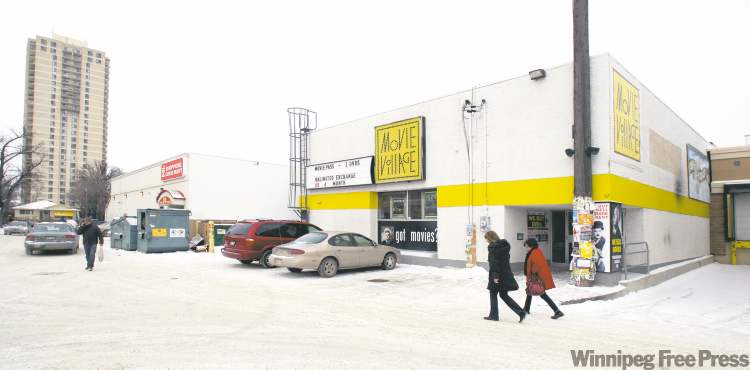Osborne Village needs big box stores to keep its unique walkability, but false fronts don’t cut it
Osborne Village needs big box stores to keep its unique walkability, but false fronts don't cut it
Advertisement
Read this article for free:
or
Already have an account? Log in here »
To continue reading, please subscribe:
Monthly Digital Subscription
$0 for the first 4 weeks*
- Enjoy unlimited reading on winnipegfreepress.com
- Read the E-Edition, our digital replica newspaper
- Access News Break, our award-winning app
- Play interactive puzzles
*No charge for 4 weeks then price increases to the regular rate of $19.00 plus GST every four weeks. Offer available to new and qualified returning subscribers only. Cancel any time.
Monthly Digital Subscription
$4.75/week*
- Enjoy unlimited reading on winnipegfreepress.com
- Read the E-Edition, our digital replica newspaper
- Access News Break, our award-winning app
- Play interactive puzzles
*Billed as $19 plus GST every four weeks. Cancel any time.
To continue reading, please subscribe:
Add Free Press access to your Brandon Sun subscription for only an additional
$1 for the first 4 weeks*
*Your next subscription payment will increase by $1.00 and you will be charged $16.99 plus GST for four weeks. After four weeks, your payment will increase to $23.99 plus GST every four weeks.
Read unlimited articles for free today:
or
Already have an account? Log in here »
Hey there, time traveller!
This article was published 15/01/2012 (5040 days ago), so information in it may no longer be current.
In December of last year, after much public protest and media coverage, the City of Winnipeg’s board of adjustment approved the expansion plans of the Shoppers Drug Mart at the corner of Osborne Street and Roslyn Road.
The store wants to take over the site of two popular neighbourhood mainstays: Vi-Ann’s Restaurant and Movie Village.
The soul of the neighbourhood, many people believed, was at stake. Two businesses unique to Osborne Village would be lost to a large, anonymous chain store that can be found in any neighbourhood across Canada.

Osborne Village, as any Winnipegger can tell you, is not just another neighbourhood. By the 1960s, it was long forgotten by the middle and upper classes, but was both edgy and south end enough for their bohemian progeny. Osborne soon emerged as Winnipeg’s modest answer to New York’s Greenwich Village or Toronto’s Yorkville.
What truly makes Osborne special is not so much that there are good places to order Pad Thai or rent Kurosawa films, but that it’s walkable.
More than any other neighbourhood in Winnipeg, it is practical to live there without a car, or at least carry out many day-to-day activities without one. And while it may pain some Village residents to admit it, having a Shoppers Drug Mart and other chain stores as part of the commercial concentration, contributes to this walkability.
Maintaining or enhancing the existing scale and commercial density that allows for walkability, is a dominant part of the Osborne Village secondary plan, which was implemented by city council in 2006. A secondary plan is a legal document that is subsidiary to the city’s master planning document, Our Winnipeg, and is developed in order to better reflect the particular character or circumstances of a neighbourhood.
The necessity of a Secondary Plan in Osborne Village emerged in the wake of the wrangling that went on between Safeway, which wanted a build a conventional big box at its River Avenue location, and Osborne Village residents, who didn’t want to see River and Osborne look like Kenaston and McGillivray. The secondary plan, it was believed, would ensure that such a lengthy fight would not be necessary the next time the neighbourhood’s “built form” was threatened.
The problem that the Shoppers expansion presents to the neighbourhood is that it is oversized and pedestrian unfriendly. In spite of its neo-traditional elements, such as a brick facade and vertically oriented windows, there is almost no new interface between the building and the street. Any interpretation of the secondary plan would suggest that the scale of an 18,000-square-foot building footprint with only one street-front entrance is fundamentally inconsistent with Osborne’s existing built form — that is, unless one thinks city neighbourhoods are simply two-dimensional objects. The report from the city’s planning department to the board of adjustment recommended approval of the expansion because the building will “read from the street” like it is traditional urbanism: three separate but adjacent buildings.
The problem is, city neighbourhoods are not read from the street, they are lived in. To the commuter racing down Osborne in their car, one kind of streetscape might look nicer than another, but for those who actually live and walk in the village, they are stuck with the way these buildings function — or the way they or don’t.
What makes neighbourhoods great is their ability to be concentrated, complex, and successfully adaptive over time. The problem with big box stores, even nice-looking ones, is that they do not easily lend themselves to any one of these things.
If there is money to be made in a certain location (as Shoppers seems to believe there is in Osborne Village), large chains conform their plans to whatever a municipal authority tells them to. Many will first submit the cheapest design template possible, but in any self-respecting city, planners kindly asks them to return to the drawing board.
In contrast, WInnipeg’s planning department seemed flattered that Shoppers was not planning total architectural banality, and eagerly construed a flimsy interpretation of the Osborne Village secondary plan, recommending approving the expansion plan as it was.
Pedestrian-friendly design is the marriage of good architectural details with good scale and usability. A good city street can do without the former, but never without the latter. Without scale and usability, all the details in the world are little more than a nice-looking but hollow false front that add nothing to the surrounding neighbourhood.



